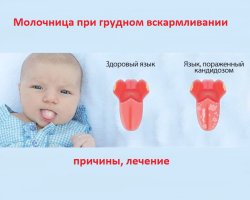Without lazy to establish breastfeeding, a woman will be able to provide her child with all the necessary nutrients, and preserving natural feeding up to two years - to help the children's immunity form and strengthen.
Content
The breastfeeding of the baby is not always the pleasure and relief of the mother. Not all women experience joyful feelings when breastfeeding the baby - cracks on nipples, pain, mastitis, lactostasis or lack of milk can bring anyone to despair.
Often young inexperienced mothers, having experienced the first difficulties of breastfeeding, are faced with a choice: to continue to feed the baby with their milk in spite of everything or transfer the baby to artificial nutrition. In order not to regret the decision, you need to figure out how important it is for the child and his mother breastfeeding.

Advantages of breastfeeding for the baby
Children of the first year of life, which are breastfeeding, grow and develop faster than their peers-articulations, because they receive all the substances necessary for the body from breast milk.
Perhaps this is the most important argument in favor of breastfeeding. However, in addition, breastfeeding provides the baby:
- fast and light absorption of milk - the main food product
- formation of immunity and protection against infectious diseases
- maximum protection against skin diseases, allergic rashes
- quick recovery after transmitted diseases
- calm and a sense of security in the mother's breast
- satisfaction of the sucking reflex without using a dummy
- good health at an older age, after the abolition of breastfeeding

Advantages of breastfeeding for the mother
It is mistaken that feeding the baby spoils the figure of a woman and selects strength. In fact, breastfeeding is useful for both the baby and for the mother. Breastfeeding women:
- are recovering faster after childbirth
- reduce the risk of breast cancer, uterus and ovaries
- are protected from the onset of a new pregnancy by the natural method
- save about $ 1,000 per year in baby food
- maintain form by observing the diet in the first months of breastfeeding
- they do not know what sleepless nights are - kids quickly fall asleep at the chest
- do not have a trouble with the preparation of the mixture, sterilization of the bottles
- associated with the baby at a thin emotional-sensory level

Disadvantages of breastfeeding
No matter how many advantages there are breastfeeding, the reverse side of the coin also makes itself felt. Errors made in the organization of feeding a child can turn it into an unpleasant, and sometimes even painful process for the mother and a dangerous process for the baby.
The nursing mother, who does not accept special vitamins, can easily lose most of the hair in the first few months after childbirth - they will begin to crumble and seize.

Tooth and nails also fall under the blow - they become unnaturally brittle and fragile. You can stop these processes by starting to take a vitamin -mineral complex for nursing.
If a nursing mother does not perform exercises, her breast, most likely, will change her shape not for the better. Loss of elasticity, a decrease or unnatural increase in size, stretching, nipples from acute teeth of a child, loss of sensitivity - all these troubles can also be in wait for tender female breasts during the feeding of the baby.
Unexpected moments for a nursing mother can also be:
- “Flowing” weak nipples - the chest may not hold the entire volume of milk and begin to spontaneously secrete it in large quantities at the most suitable moment
- round -the -clock attachment to the feeding mode - if the child is not accustomed to the bottle, the mother will have to be constantly nearby, so as not to leave the child hungry for a long time
- baby refusal to sleep without a mother's chest
- the need to observe a strict diet in order to avoid the appearance of a child in a colic, problems with stools and allergic reactions
- drowsiness arising under the influence of the body produced by the body during endorphins feeding

Important: all of the listed troubles of breastfeeding, a woman will be able to avoid, preparing for the upcoming morally and physically.
Breastfeeding can become unsafe for the baby if:
- mom does not observe a diet, eats spicy, fried, smoked and fatty foods
- mom consumes alcohol and coffee, smokes
- the baby has lactose intolerance
- mom can fall asleep tightly during feeding and accidentally crush the baby, blocking the air supply to him
Natural feeding of children of the first year of life: Rules and periods
To establish natural breastfeeding is not so easy. In the first few days after the birth of milk, the mother may not be at all. This is absolutely normal, but many women, out of ignorance, do not apply the child to their breasts, thereby making a serious mistake already at this initial stage.
Important: the child should be attached to the chest for the first time in the maternity room, immediately after childbirth. It is very important for the baby to get colostrum, which necessarily comes before milk.

In the future, the child is given breasts as often as possible. As practice shows, women who do not adhere to feeding graphics and give breasts on demand, manage to preserve milk and establish breastfeeding more often than mothers who feed their babies “by the clock”.
Young mother should not be submitted to the persuasion of older relatives “give the child a mixture to eat” and pay attention to their meaningful sighs about the duration of the child’s stay near the chest.
Important: the first 2 - 4 months, many children instinctively ask for their hands under the chest. At the same time, the child can suck in order to get enough, only 10 - 20 minutes, and the rest of the time just sleep, without releasing the nipple from his mouth. Do not deprive the baby of this pleasure. Very little time will pass, and he himself will set the most acceptable schedule of food and rest.
It is noteworthy that those mothers who feed the child on demand, itself will disappear the problem of expressing. The breast is not overflowing with "excess" milk.

In the former Soviet Union, young mothers were taught to adhere to a feeding schedule, withstanding three -hour intervals. This is absolutely wrong. After all, while the child is very small, the need for mother's milk can occur every 1 - 1.5 hours. Thus, adhering to the schedules and observing the schedules, the mother simply deprives the child of the necessary nutrition.
Important: there is no need to be afraid that the child is overeating or not finishing. Nature will wisely put everything in its place, and the mother’s work is simply to give breasts to the baby for every desire.
After complementary foods appear in the baby’s diet, his need for breast milk will decrease. Gradually, mother will be able to replace breastfeeding, offering the child the products introduced earlier.

Until how long to breastfeed?
It is impossible to determine the optimal age of the baby for excommunication from breastfeeding. Some children themselves abruptly abandon the breast, as soon as they try complementary foods, others leave her mother’s breast gradually, applying only at night or in stressful situations, and others are not ready to say goodbye to their favorite delicacy even at the age of three.
The erroneously obsolete opinion is that feeding breast milk of a baby older than 1 year is inappropriate. It was previously believed that the “late” milk no longer contains useful substances necessary for the growth and development of the baby.
Important: recent studies have proved that over time in breast milk, the percentage of fat content and the content of vital vitamins and trace elements increases. Continuing to receive breast milk after a year, children almost completely satisfy the body's need for protein, calcium, vitamins A, B12, S.
To date, WHO recommends breastfeeding a baby up to 2 years. Ideally, if the baby leaves his breast at his own, consciously refusing to get food in the usual way for him.

Do not look around in search of the right solution. Each mother is able to intuitively feel whether her child is ready for excommunication. To do this, it is enough to only listen to yourself and your child.







